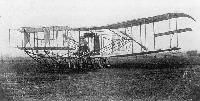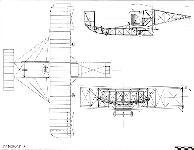P.Lewis British Aircraft 1809-1914 (Putnam)
Sanders Biplane No. 2
After its crash on 13th February, 1910, at Benacre Down, Suffolk, the Sanders Type 1 was removed to Beccles, where it was rebuilt, being drastically altered at the same time.
Strength was a prime consideration, and the machine was constructed of steel tubing and wood; special attention was paid to the safety of the pilot. The curved tips were retained on the upper wings, while the lower pair were shorter in span than the upper set. The fuselage framework was uncovered and incorporated the tricycle landing-gear, the rear wheels of which were retracted upwards into the fuselage by a trip device once the machine was airborne. Landing was effected on the skids alone to give a quick stop, as on the Short No. 3. A motor-car type of steering wheel on a universal joint operated the biplane fore-elevator, the ailerons, which were carried on the outer rear interplane struts, and the three slim rudders at the rear. Engine power was increased by fitting a 50 h.p. Alvaston in place of the Brooke. Further testing of the machine was done for the rest of 1910 until it was modified once again.
In its final form the Sanders Biplane was redesignated Type 2 and appeared at the 1911 Olympia Aero Show. Yet another change of engine had been made with the installation of an eight-cylinder 60 h.p. E.N.V. "F". The twin propellers had been abandoned and a single 9 ft. diameter Sanders-built flywheel-driven propeller was fitted. To provide sufficient clearance for it, the rear tail booms were moved outwards at their fixing points on the trailing-edges of the wings, which themselves were hinged to fold forward for storage.
SPECIFICATION
Description: Single-seat canard pusher biplane. Steel-tubing and wooden structure, fabric covered.
Manufacturers: Sanders Aeroplane Co., The Common, Beccles, Suffolk, and London Aeroplane and Aerial Navigation Co., 23 Blenheim Park Road, Croydon, Surrey.
Power Plant: 50 h.p. Alvaston, 60 h.p. E.N.V. "F".
Dimensions: Span, 40 ft. Length, 31 ft. 6 ins. Wing area, 444 sq. ft.
Weights: Empty, 1,100 lb.
Price: ?1,000.
Показать полностью
M.Goodall, A.Tagg British Aircraft before the Great War (Schiffer)
Deleted by request of (c)Schiffer Publishing
SANDERS teacher.
After the crash of No.l, Sanders moved to Beccles where a ground trainer was constructed with control surfaces and structure representative of those to be used for No.2.
SANDERS biplane No.2 Types 1 and 2 (Sanders Aeroplane Co., Beccles, Suffolk)
The second Sanders biplane was made in two versions and had quite a different fuselage from No. 1, although contemporary reports referred to 'reconstruction' taking place. The only report of flight refers to three over Beccles Common, where the machine was constructed. These took place on 30 April 1911, when a height of forty feet was achieved and a speed of 40mph. This was soon after the Type 2 aircraft had been exhibited at Olympia in March and probably refers to that machine.
The Type 1 was illustrated in March and must have been tested earlier in the year, but no evidence of flight can be traced. In advertisements in June 1911 the machine was referred to as the 'Aerial Cruiser' with a 'Sanders Patent Aerial Gun'.
The two versions were basically identical, except for the power, which on the Type 1, had twin pusher propellers, whereas the Type 2 had a single larger propeller. This change necessitated widening the gap between the tail booms to provide clearance, which then tapered to the tail in plan, instead of being parallel as on No.l.
The main girder took the form of an extended undercarriage structure and formed a mounting for the front biplane elevator, which incorporated two small fixed fins. The undercarriage consisted of a nose-wheel and a pair of main wheels on a rubber cord sprung axle, which after takeoff could be retracted to allow the machine to land on the skids to reduce the landing run. The top wing had the down turned tips, as used previously, but the lower was of reduced span, cut squarely at the outboard interplane struts with wingtip skids below. Outboard of the center section were three pairs of interplane struts, the two rear outers being used to mount the ailerons. On the twin pusher version, further pairs of struts were necessary to mount the bearings for the propeller shafts. The outer wing bays, with the ailerons, could be folded forward to reduce the span for storage. Elevator flaps were again fitted to the top and bottom center sections on the first version but were not present on the machine at Olympia. Three narrow chord rudders were fitted at the tail. The pilot again sat ahead of the engine which was flanked on either side by coolant radiators, with a fuel and oil tank above.
The first machine had an Alvaston engine with the twin propellers driven by chains. The second machine had an ENV, driving a single propeller by chain on a shaft mounted above. A report that Sanders' aircraft was converted to a waterplane and was in Northumberland in 1913 has not been confirmed.
Power:
No.1 50hp Alvaston four-cylinder horizontally opposed water-cooled driving two 8ft 6in diameter propellers by chains and shafts.
No.2 60hp ENV type F eight-cylinder water-cooled vee driving a 9ft diameter Sanders propeller by chain and shaft at a ratio of 1.4 to 1.
Data for Type 1.
Span 40ft
Chord 6ft
Area 472 3/4 sq. ft (inc. tailplanes)
Length 31ft 6in
Front elevator span 12ft
Front elevator chord 3 ft
Front elevator area 72 sq. ft
Rudders height 6ft
Rudders chord 1ft
Rudders area 18 sq. ft
Ailerons span 7ft
Ailerons chord 2ft
Ailerons area 4 sq. ft each
Weight
1,100 lb. (Type 1)
1,000 lb. (Type 2)
Показать полностью
Журнал Flight
Flight, March 4, 1911
THE SANDERS BIPLANE.
FROM A CORRESPONDENT.
THOSE who have followed the progress of aviation and the development of the aeroplane know that the thirty odd different types of British machines now in existence all have some speciality in their design or construction of which their inventors expect great things. There are, however, few machines with so many novel features as the Sanders biplane now flying at Beccles. It was in June, 1909, that Captain Sanders first flew, and from that date until February, 1910, when his experiments came to a temporary but abrupt conclusion through an unfortunate collision with the telephone wires, he steadily gained mastery over his machine. Nothing daunted by his mishap, reconstruction was at once commenced and the works were at this time also removed to Beccles, where very shortly a flourishing firm was established. Now there is a large shed that houses the biplane and adjacent to it a workshop equipped with every facility for building duplicates. Every portion of the machine is manufactured in these shops, except, of course, the wheels, engine and certain small fittings that are made outside to the firm's own designs.
In the present Sanders biplane, known as Type 1, because the first of its kind on the market, strength and attention to detail have been aimed at rather than lightness of construction. It should not be inferred, however, that the machine is cumbersome, but rather that the safety of the pilot has been made the first consideration of design. As a type it is of considerable interest, inasmuch as it is a biplane, with a forward elevator and no tail. It has, however, a triplane rudder carried on an outrigger 12 ft. behind the trailing edges of the main planes and a very peculiar feature of the main planes themselves is that in the centre their own trailing edges are extended by hinged flaps that form a kind of atrophied tail. At the extremities of the planes, midway in the gap between the trailing edges, are supplementary balancing planes. There are also two other supplementary planes in the form of a prow, which is mounted vertically between the planes of the elevator. One of the most important and interesting details of the construction of the Sanders biplane is the under carriage, a massive girder construction, extending from the main planes to the elevator. It is supported on three wheels, two immediately under the main planes and one well forward. The single wheel is so sprung that it easily adjusts itself to the attitude of the machine when running over the ground and it is the wheels at the rear that carry the greater part of the weight. They revolve on an axle suspended on rubber springs and these springs are so arranged that they can be released by a lever after ascent, and the wheels are thereby drawn up above the level of the skids. Landing is thus accomplished on the skids direct, which not only saves the wheels and axle from damage, but generally is the means of alighting with greater safety.
The control of the machine is effected by a steering-wheel mounted, motor car fashion, on an inclined column, which has a universal motion on its pivoted support in addition to the rotary motion imparted by the wheel. Moving the steering column sideways controls the balancing planes, while the rudder answers to the circular motion of the wheel. The elevator is controlled by duplicate levers, one on either side of the pilot's seat.
At present the machine is fitted with a 50-h.p. Alvaston motor, which is water-cooled through spiral tube radiators mounted alongside the pilot's seat. The radiators are slightly offset to the direction of flight in order to get a n equal draught over all the tubes. Twin propellers of 8 ft. 6 ins. diameter are carried by brackets midway in the gap immediately behind the main planes and are driven by chains at 400 r.p.m. The entering edge of the propeller-blade is peculiar and similar in principle to the entering edges of the main planes, which are concave instead of convex, the idea, according to the designer, being that the air is compressed on contact and afterwards expands against the lower surface.
The main planes have a dihedral angle and the upper plane, which overlaps the lower plane, has down-turned extremities. Both planes are built in three sections and can be easily dismantled. Silver spruce is used throughout for the construction of the spars and framework generally, except for the engine-bed, which is made of ash, and the diagonal bracing of the under-carriage, for which strip manganese steel is used. Pegamoid cloth is used as a surfacing material.
A new type of biplane is at the present moment being constructed and will be exhibited at Olympia. It will differ, among other respects, from the type illustrated in having a single propeller instead of two.
Flight, April 1, 1911.
Third International Aero Exgibition at Olympia - 1911.
THE EXHIBITS ANALYSED.
<...>
The Sanders aeroplane is fundamentally a modification of the original Wright biplane, as its only tail member is the rudder, and there is an elevator in front. This elevator, however, probably carries proportionately more load than on the original Wright, because the very strong Short type girder under-carriage is probably heavier than the corresponding outrigger on the original Wright machine. These girder skids and the elevator itself are, to all intents and purposes, the same as those on the Short biplane last year. The main planes themselves are characterised by sharply downturned extremities on the upper plane that act as side curtains to prevent leakage and sideslip. The engine and propeller on the Sanders biplane are arranged more or less on the same lines as the Cody - that is to say, the propeller is mounted midway in the gap and is driven at hall engine speed by a single vertical chain. The rudder is a triplane, in which respect it differs from the biplane rudder on the Wright.
<...>
Показать полностью













